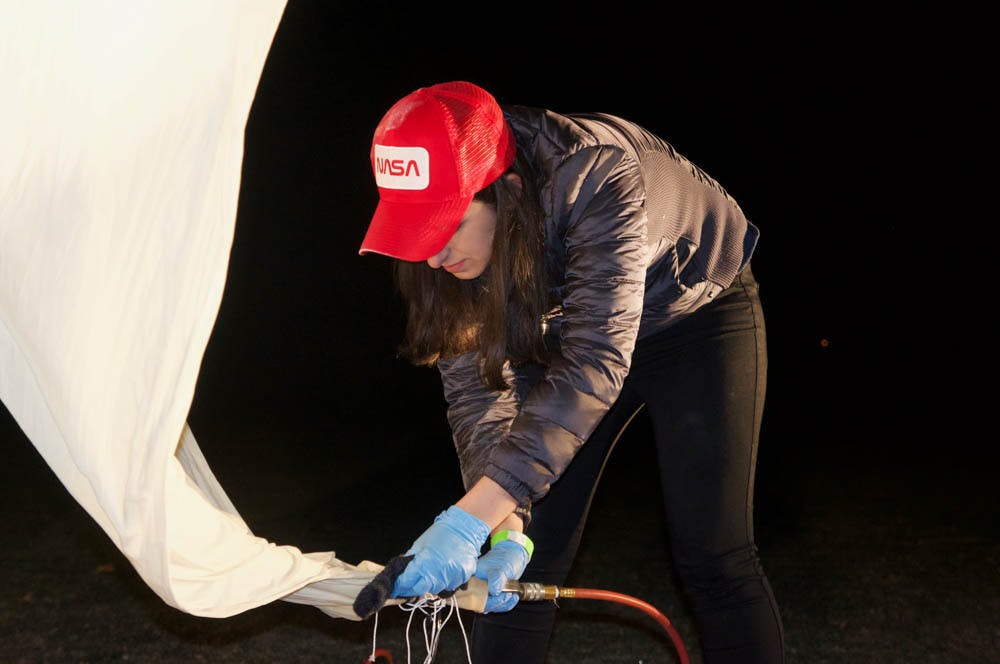Brown Space Engineering launched a balloon into the upper atmosphere near Springfield, Mass. the morning of Sunday, Oct. 1 as part of a project meant to test new technology and demonstrate the accessibility of space. The balloon reached a height of nearly 100,000 feet and then flew south for two hours before landing in an 80-foot tree in Lebanon, Connecticut, according to Henry Belcaster ’19, the leader of the team behind the balloon project.
The balloon was equipped with a number of information-gathering apparatuses, said David Schurman ’20. The balloon itself was attached to a 3.5-kilogram payload, which has sections carved out to hold the technology. It contained a live analog camera that the team checked in real time, a GoPro and a 360-degree video camera.
At the Earth’s surface, the balloon was 12 feet in diameter, Belcaster said. The latex balloon was filled with helium, which would cause it to rise.
The team carefully planned the launch: After between an hour and a half and two hours, the balloon would reach peak height with a diameter of about 35 feet. At this point, the pressure inside the balloon would exceed that of the atmosphere, and the balloon would burst. A parachute attached to the payload would then deploy, and the contraption would float back down to Earth. The team would track the balloon, which might end up 50 to 60 miles away, via a GPS locator.
This is the second balloon launch of the project, Schurman said. At the beginning of last year, the research and development sector of Brown Space Engineering began to look toward the future of space technology and how it could be tested. The resulting idea was to launch a balloon to immensely high altitudes. They began planning that semester and started to assemble the balloon at the beginning of spring. The team launched the first balloon that April, but there were a number of problems. The electronics died before launch due to a bad battery and the assembly process was not organized enough, Schurman said.
This second launch was executed “with great success,” Belcaster wrote in an email to The Herald. “Previous systems that failed in our spring launch lasted the entire flight,” he added.
Planning for the second launch began this summer, and the team strived to rectify the issues from the previous one, Schurman said. Development continued, culminating with the launch Oct. 1. Another launch is planned for the spring, Belcaster added.
The balloon was supposed to collect many different sorts of information, said Asutosh Swain ’20, who worked on the project. Virtual reality would allow people to view the extended 360-degree footage, and there would also be a temperature and altitude reading.
There are a number of organizations that use high-altitude balloons, Belcaster said. The federal government and various meteorological services take advantage of them, as they give a good reading of the atmosphere while being low-cost and quick to return data.
One of the main purposes of the launch was to test technology for future projects. Brown Space Engineering is currently working on a satellite called EQUiSat, which is a 10-centimeter “CubeSat.” Its LED lights will be visible from space, shining as brightly as the North Star, Swain said. It will be launched from the International Space Station in March, Schurman said. He also said that the purpose was to make a satellite that was not costly; indeed, the team is aiming to build the satellite for a total of $5,000.
Another central focus of the launch is to dispel the perception of space as esoteric, Swain said. Many people have the notion that sending technology into space is an expensive and long endeavor, which is not the case, he added. Making space seem more accessible is one of the goals of the balloon project, emphasized by the fact that there were a number of freshman on the “balloon team,” he said.





